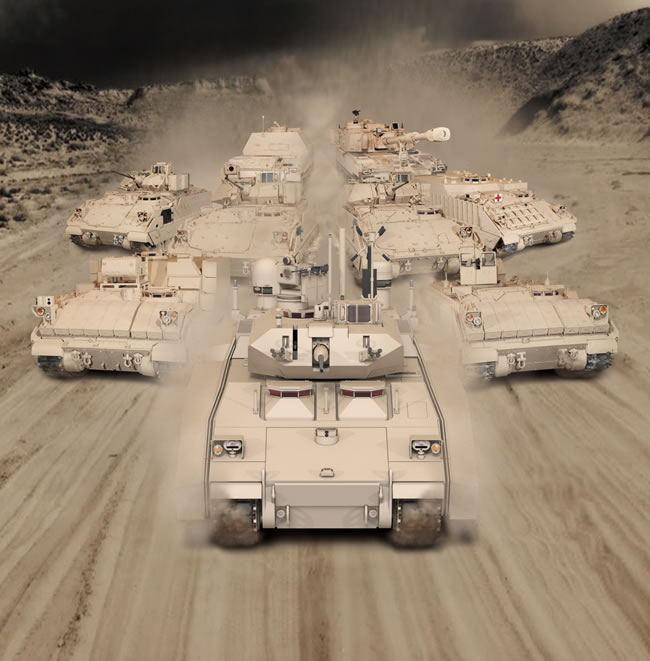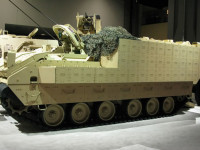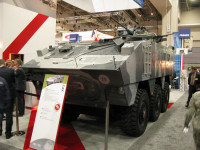

The absence of new programs provided exhibitors an opportunity to highlight improvement to existing platforms. Among the combat vehicles displayed at AUSA were the M-109 Paladin Improved Mobility (PIM) and Bradley, both included in the US Army’s Enhanced Capability Programs (ECP). Neither BAE its partner Northrop Grumman nor their competitor General Dynamics Land Systems and Lockheed martin provided much information on the next big thing for the Army – the Ground Combat Vehicle (GCV) although BAE did shed some light on the innovative hybrid electric propulsion system proposed for their GCV candidate.
Another Army program capturing much attention is the Advanced Multi-Purpose Vehicle (AMPV) – the planned replacement of the M-113, scheduled for the 2020. This program attracts significant interest in the US and abroad, with the potential for selling up to 3,800 tracked or wheeled vehicles to equip up to 15 Brigade Combat Teams (BCT). Improvements for the Stryker are also underway, following the introduction of the Double-V-Hull (DVH) modification, offering much improved protection.

The DVH increases the vehicles’ weight and to gain back performance, the engine, suspension and power generation systems will be upgraded. The Army might also consider another modification, converting the vehicle into electrically driven platform, by switching the current axle-drives with hub-in-wheel electrical motors. Parker unveiled such concept at AUSA 2012 and is planning to demonstrate this capability in the near future. The upgraded DVH Stryker is also considered as a future M-113 replacement as one of the AMPV candidates. To beat the Army’s notional bias towards tracked platforms, GDLS displayed a tracked Stryker-TR concept vehicle at AUSA 2012. This vehicle used standard M-113 tracks mated with a Stryker body, without too much optimization. If the Army expresses interest in such option, the company would further optimize the vehicle, GDLS executives said, stressing that the upgraded wheeled Stryker can fully meet the AMPV requirements in terms of performance, sustainability and operating cost.
Other companies courting the Army for the AMPV included Textron Systems that recently rebranded its armored vehicle family as ‘Commando’. At AUSA the company had three variants of Commando on display. The Commando Advanced (formerly designated M-1117 ASV, where it was one of the first combat vehicles to have a V-shaped hull. Thousands are in service with the US and Iraqi Army. The new Commando Select was an upgrade of the ASV, offering MRAP-class mine and blast protection. 440 are currently built to equip the Afghan National Army mobile strike force. The Canadian Army recently selected the Commando Elite for the TAPV program. The vehicle offers MRAP Type-2 protection. Under this contract Textron will deliver 500 such vehicles between 2014 and 2016 and Canada has an option to buy 100 additional vehicles if needed. In October Rheinmetall Canada acting as the prime subcontractor was awarded C$205 million sub-contract for its share of the program. With more than a thousand M-1117s operational with the US Army, the Commando could prove a logical entry for the AMPV.

The French vehicle manufacturers Nexter and Renault (through local affiliate Mack) are also proposing relevant vehicles. Although Nexter promoted its vehicle development capabilities through the XP2 technology demonstrator platform, one of two candidates for the French Army next generation APC. While Nexter can only hope to sell its XP2 TD to the US, the more likely goal for Nexter is to introduce its automatic cannon firing 40mm Caseless Telescopic Ammunition CTA40, developed under cooperation with the British company BAE Systems.

The British and French Armies have already adopted the new cannon for their future combat vehicles and potential penetration of the US market, for example, as the primary weapon for the Ground Combat Vehicle (GCV), could have significant implications on the acceptance of this advanced weapon worldwide. Renault, a subsidiary of the Volvo group, promoted here a 105mm SP gun mounted on a Sherpa. Yet the company also has a broad range of armored vehicles that could fit a future US requirement.
BAE Systems is focusing on the Bradley for the AMPV, offering five new derivatives as successors for the M-113s. The company is also prepares wheeled vehicles for a parallel Marine Corps requirement for the Marine Personnel Carrier (MPC) program. The company is teaming with Iveco to promote the amphibious SuperAV 8×8 troop carrier for the BAE Systems is not the only bidder offering a foreign design for the MPC program. In fact, all the platforms considered for the program are foreign – The Italian SuperAV will compete against Lockheed Martin’s Havoc 8×8 (based on Patria AMV from Finland) and the Swiss developed Piranha V, a heavier and more powerful version of the LAV-25 currently used by the corps, produced GDLS.



















